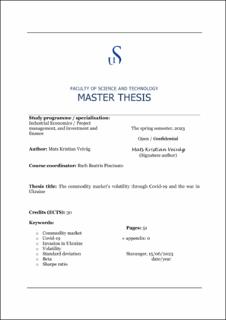| dc.description.abstract | In early 2020 a pandemic quickly led to major shutdowns of production and travel to prevent the spread of the Covid-19 virus, and lockdowns affecting the supply chain stopping the flow of materials and goods. Because of this the demand for energy shifted downwards leading to a fall in several commodity prices. This is due to energy being used for both production and transport, so a decrease in energy demand will lead to a decrease in price. Further the invasion of Ukraine led to another major shift in several markets as the war affected the supply of some major commodities, as Europe, United States, and other nations sanctioned Russia, leading to long term consequences on the commodity markets. The commodity prices increased rapidly, especially for commodity groups as energy, fertilizers, grains, and metals, where Ukraine and Russia are big exporters. Both events have led to higher volatility and uncertainty in the commodity market and have made the basis to investigate the research question on how the commodity market and the volatility revolving commodities have been impacted. By using a moving standard deviation this analysis explores how volatility has changed from the start of 2015 until the end of 2022. Further by using a moving beta and Sharpe ratio the relative risk is analyzed for the same interval, comparing each commodity to gold, as gold often is seen as a safe-haven by investors.
The empirical data shows that the energy commodities are the ones with highest volatility in the pre-covid period. As the pandemic hits crude oil is the only commodity making a big immediate leap as soon as society locks down. It is then quickly followed by an increase in volatility from gold, natural gas, and copper. Later into 2020 wheat and coal volatility starts to increase as well, while Nickel already had a relatively high volatility and see some variations. Further into 2021 we see most commodity volatilities starting to fall again, except for coal and natural gas who make large jumps. As the war in Ukraine starts in early 2022 other commodities like crude oil, nickel and wheat make large leaps in volatility as well, later followed by copper. Gold does not show any change in volatility during the period. Looking at the beta and the relative risk, for the pre-covid period it is shown that the commodities are mostly less volatile relative to gold, except for natural gas that often exceeds gold volatility. This is the case until the war starts in 2022 when we see a large leap in all commodities beta. Overall gold is shown to be riskier than the other commodities before the war, and after the war starts the other commodities show a larger level of risk compared to gold. Furthermore, the Sharpe ratio shows that the commodities follow mostly the same pattern where gold is the better investment in the first 3 quarters of 2016, as well as from 2019 until 2021. However, the commodities are better investments from late 2016 until late 2018, as well as from 2021 until mid- to late-2022, where gold becomes a better investment option than most of the commodities by the end of 2022. | |
